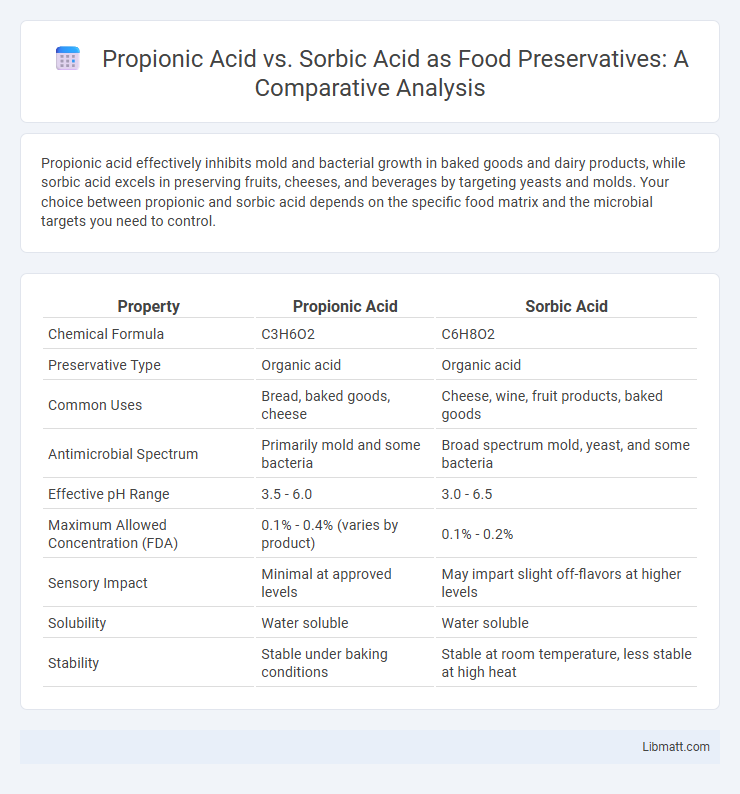Propionic acid effectively inhibits mold and bacterial growth in baked goods and dairy products, while sorbic acid excels in preserving fruits, cheeses, and beverages by targeting yeasts and molds. Your choice between propionic and sorbic acid depends on the specific food matrix and the microbial targets you need to control.
Table of Comparison
| Property | Propionic Acid | Sorbic Acid |
|---|---|---|
| Chemical Formula | C3H6O2 | C6H8O2 |
| Preservative Type | Organic acid | Organic acid |
| Common Uses | Bread, baked goods, cheese | Cheese, wine, fruit products, baked goods |
| Antimicrobial Spectrum | Primarily mold and some bacteria | Broad spectrum mold, yeast, and some bacteria |
| Effective pH Range | 3.5 - 6.0 | 3.0 - 6.5 |
| Maximum Allowed Concentration (FDA) | 0.1% - 0.4% (varies by product) | 0.1% - 0.2% |
| Sensory Impact | Minimal at approved levels | May impart slight off-flavors at higher levels |
| Solubility | Water soluble | Water soluble |
| Stability | Stable under baking conditions | Stable at room temperature, less stable at high heat |
Introduction to Food Preservatives
Propionic acid and sorbic acid are widely used food preservatives known for their effectiveness in inhibiting mold and bacterial growth, thus extending shelf life. Propionic acid is especially effective in baked goods and dairy products, providing antimicrobial action without altering flavor significantly. Sorbic acid excels in acidic foods like fruit juices and cheeses, offering strong preservative properties that help maintain product quality and safety for your consumption.
What is Propionic Acid?
Propionic acid is a naturally occurring organic acid commonly used as a food preservative due to its antimicrobial properties, particularly effective against molds and bacteria in bakery products. It functions by inhibiting the growth of spoilage microorganisms, extending shelf life without altering the food's flavor significantly. Compared to sorbic acid, propionic acid is especially valued for its strong activity against mold in high-moisture environments.
What is Sorbic Acid?
Sorbic acid is a natural preservative widely used in the food industry to inhibit mold, yeast, and fungal growth, extending shelf life without altering flavor. Chemically known as 2,4-hexadienoic acid, sorbic acid is effective in acidic foods with a pH below 6.5, commonly found in baked goods, cheese, and beverages. Compared to propionic acid, sorbic acid offers broader antimicrobial activity, particularly against molds and yeasts.
Mechanisms of Preservation: Propionic vs Sorbic Acid
Propionic acid preserves by disrupting microbial cell membrane integrity and inhibiting enzyme activity involved in energy production, effectively targeting molds and some bacteria. Sorbic acid works by penetrating microbial cells and interfering with intracellular enzymes, preventing mold, yeast, and bacterial growth primarily in acidic food environments. Your choice between propionic and sorbic acid should consider the specific microbes you need to control and the pH level of your product for optimal preservation efficacy.
Antimicrobial Spectrum: Comparative Effectiveness
Propionic acid and sorbic acid exhibit distinct antimicrobial spectra, with propionic acid primarily targeting molds and certain bacteria, while sorbic acid is more effective against yeasts and molds. Propionic acid is widely used in baked goods to inhibit mold growth, leveraging its strong antifungal properties, whereas sorbic acid is preferred in beverages and dairy products for its broader yeast and mold inhibition. Your choice between these preservatives should consider the specific microbial challenges of your product to ensure optimal preservation efficacy.
Food Applications: Where Are They Used?
Propionic acid is widely used in bakery products due to its effectiveness against molds and bacteria, particularly in bread, cakes, and pastries, extending shelf life without altering flavor. Sorbic acid is primarily applied in cheese, wine, and fruit-based products because of its strong antifungal properties, inhibiting yeast and mold growth in acidic environments. Both preservatives are valued for their safety and efficacy, but their usage depends on the food matrix and pH conditions to maximize preservation performance.
Safety and Regulatory Status
Propionic acid and sorbic acid are both widely recognized as safe preservatives, with propionic acid primarily used in baked goods and sorbic acid common in cheese and beverages. Regulatory agencies like the FDA and EFSA approve both, but sorbic acid is generally favored due to its lower toxicity and fewer reported allergic reactions. To ensure compliance and safety, you should check product-specific concentration limits, as exceeding these can pose health risks.
Impact on Food Quality and Taste
Propionic acid effectively inhibits mold and bacterial growth in baked goods without significantly altering the flavor profile, making it ideal for bread and bakery products. Sorbic acid provides broad-spectrum antimicrobial protection, particularly in cheese and beverages, but may impart a slightly sharp or tangy taste at higher concentrations, potentially affecting sensory qualities. Both preservatives maintain food quality by extending shelf life, yet propionic acid's neutral taste impact often makes it preferable where flavor preservation is critical.
Consumer Preferences and Labeling
Propionic acid and sorbic acid serve as effective preservatives but differ in consumer perception and labeling appeal. Sorbic acid is often preferred by consumers seeking "natural" or "clean label" products since it is derived from berries and fungi, while propionic acid, synthesized industrially, may be viewed less favorably despite its efficacy in inhibiting mold and bacterial growth. Clear labeling regulations require disclosure of both acids on ingredient lists, with sorbic acid frequently marketed as potassium sorbate to enhance consumer acceptance and align with clean label trends.
Conclusion: Choosing the Right Preservative
Selecting between propionic acid and sorbic acid as preservatives depends on the specific application and desired antimicrobial spectrum. Propionic acid is particularly effective against molds and some bacteria, making it ideal for bakery products and cheeses, while sorbic acid offers a broader antifungal range, often preferred in beverages, dairy, and processed foods. Evaluating factors like pH stability, solubility, and regulatory approvals ensures optimal preservation and product safety.
propionic acid vs sorbic acid as preservatives Infographic

 libmatt.com
libmatt.com